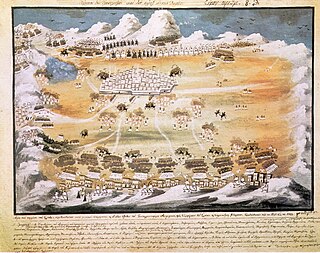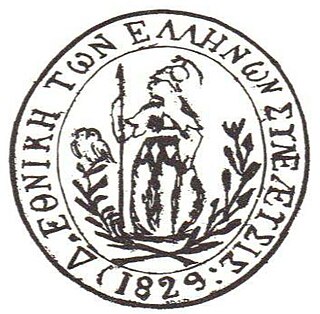
The Greek War of Independence, also known as the Greek Revolution or the Greek Revolution of 1821, was a successful war of independence by Greek revolutionaries against the Ottoman Empire between 1821 and 1829. In 1826, the Greeks were assisted by the British Empire, Kingdom of France, and the Russian Empire, while the Ottomans were aided by their vassals, especially by the Eyalet of Egypt. The war led to the formation of modern Greece, which would be expanded to its modern size in later years. The revolution is celebrated by Greeks around the world as independence day on 25 March.

Demetrios Ypsilantis was a Greek army officer who served in both the Hellenic Army and the Imperial Russian Army. Ypsilantis played an important role in the Greek War of Independence, leading several key battles. He was also member of the Filiki Eteria and the younger brother of Alexander Ypsilantis.

Theodoros Kolokotronis was a Greek general and the pre-eminent leader of the Greek War of Independence (1821–1829) against the Ottoman Empire.

The Ottoman–Egyptian invasion of Mani was a campaign during the Greek War of Independence that consisted of three battles. The Maniots fought against a combined Egyptian and Ottoman army under the command of Ibrahim Pasha of Egypt.

Andreas Metaxas was a Greek politician, fighter of the Greek War of Independence and diplomat from Cephalonia. He was prime minister of Greece from 3 September 1843 to 16 February 1844. Some military leaders of the revolution (Makriyannis) gave him the ironic nickname of "Conte Lalas'" due to his injury during the Battle of Lalas.

The Maniots or Maniates are an ethnic Greek subgroup that traditionally inhabit the Mani Peninsula; located in western Laconia and eastern Messenia, in the southern Peloponnese, Greece. They were also formerly known as Mainotes, and the peninsula as Maina.

Konstantinos Mavromichalis, brother of the Bey of Mani, Petros Mavromichalis, was a Greek military commander of Maniot forces during the Greek War of Independence, and the assassin of the first head of state of Greece, Ioannis Kapodistrias.

The First National Assembly of Epidaurus was the first meeting of the Greek National Assembly, a national representative political gathering of the Greek revolutionaries.

Yiannis Makriyiannis, born Ioannis Triantaphyllou, was a Greek merchant, military officer, politician and author, best known today for his Memoirs. Starting from humble origins, he joined the Greek struggle for independence, achieving the rank of general and leading his men to notable victories, most notably the successful defense of Nafplio in the Battle of the Lerna Mills. Following Greek independence, he had a tumultuous public career, playing a prominent part in the granting of the first Constitution of the Kingdom of Greece and later being sentenced to death and pardoned.

Manto Mavrogenous was a Greek princess and heroine of the Greek War of Independence. An extremely wealthy aristocrat, she contributed her fortune for the Hellenic cause. Under her encouragement, her aristocratic European friends contributed money and guns to the revolution.

The Battle of Dervenakia was the Greek victory over the Ottoman forces on 6–8 August 1822, an important event in the Greek War of Independence.

The siege of Tripolitsa or fall of Tripolitsa, also known as the Tripolitsa massacre, was an early victory of the revolutionary Greek forces in the summer of 1821 during the Greek War of Independence, which had begun earlier that year, against the Ottoman Empire. Tripolitsa was an important target, because it was the administrative center of the Ottomans in the Peloponnese.

The siege of Navarino was one of the earliest battles of the Greek War of Independence. It resulted in one of a series of massacres which resulted in the extermination of the Turkish civilian population of the region.

The Battle of Vasilika was fought between Greek revolutionaries and the Ottoman Empire during the Greek War of Independence.

The Mavromichalis family is a Greek family from Mani Peninsula, which played a major role in modern Greek history.

The Battle of Doliana occurred on 30 May 1821 N.S. during the Greek War of Independence when Greek revolutionaries defeated the forces of the Ottoman Empire at Doliana in the Morea province of the Ottoman Empire.

The Fourth National Assembly at Argos was a Greek convention which sat at Argos from 11 July to 6 August 1829, during the Greek War of Independence.
The Greek civil wars of 1823–1825 occurred alongside the Greek War of Independence. The conflict had both political and regional dimensions, as it pitted the Roumeliotes, who lived in mainland Greece, and shipowners from the Islands, primarily Hydra island, against the Peloponnesians or Moreotes. It divided the nation, and seriously weakened the military preparedness of the Greek forces in the face of the oncoming Egyptian intervention in the conflict.

Konstantinos Metaxas was a Greek fighter of the Greek War of Independence and politician from Cephalonia.
Marigo Zarafopoula was a person of the Greek War of Independence and member of the Filiki Eteria, a secret 19th-century organization whose purpose was to overthrow the Ottoman rule of Greece and establish an independent Greek state.





















